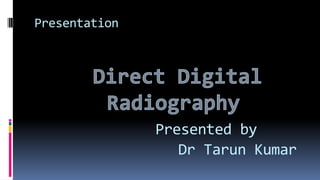
Direct digital radiography(1) (1)
- 1. Presentation Presented by Dr Tarun Kumar
- 2. Topics covered/ Table of contents 1)Types of radiography 2) Film screen radiography ,digital radiography 3) Computed and direct digital radiography 4) Process of imaging in direct digital radiography 5) Advantages of direct digital radiography 6) Advancement in direct digital radiography
- 3. Types of Radiography Film screen radiography Digital radiography
- 4. Film screen radiograph Film itself act as Image receptor Display medium Medium for image storage Used for decades in past. Now largely replaced by digital radiography
- 5. Film screen radiography cont... Uses intensifying screens Film is placed between two intensifying screens Screens emit light when x-rays strike them causing change in film Film is processed chemically
- 6. Limitations of film screen radiography No Manipulation – Cant be manipulated i.e. magnification, cropping ,windowing, etc are not possible Storage – Image quality deteriorates over time - Requires large space and more management for storage Transmission – loss of quality during transmission. - Loss of quality during duplication
- 7. Digital radiography When digital detectors are used to capture information then its called digital radiography Films and Screens are replaced by digital detectors. • Image reception ,display and storage are done separately.
- 8. Advantages of digital radiography Manipulation – can be magnified ,compressed ,cropped ,contrast enhanced. Storage – stored in digital files requiring much less space - no reduction in quality on long time storage Communication – Can me made into multiple copies without loss of. quality - Can be easily send anywhere through PACS
- 9. Two Types of digital radiography Computed radiography system i.e. CR Direct digital radiography system i.e. DR
- 11. Computed radiography system CR Operational in Radiology department of PMCH CR contains photo illuminable Phosphor plates acting as detecting and storage layer in place of conventional films. Coating of europium activated barium fluorohalide is used in these phosphor plates.
- 12. Process of imaging in computed radiography On exposure to X ray energy is absorbed and stored temporarily by crystals in the plate Readout process – plate is scanned with high energy laser beam and energy stored in .crystals is set free in form of light photons. Light thus emitted is collected and converted into digital images.
- 13. Computed Radiography cont... Imaging plate can be reused after exposure to white light It can be easily integrated into existing conventional setup and produce digital images that can be stored and communicated digitally. Imaging plates are expensive and can easily get damaged by manual handling.
- 14. Direct digital radiography No cassettes reading or film development required. Signal from X ray receptor is directly send to computer for image reconstruction Minimal work is required by technician
- 15. Direct digital radiography Has flat panel detectors or charge couple devices which are connected to computers with wires Image is available within seconds of image capture But needs new installation in X ray room
- 18. DR Readout process Charges are generated by Direct and indirect conversion process Sensed by electric readout mechanism present in thin film transistor array Analog to digital conversion performed and images produced
- 19. Types –Direct digital radiography Direct digital radiography can be of two types 1) Direct conversion type – Photoconductors like amorphous selenium directly convert X-rays into electrical charges.
- 20. Types – DR 2)Indirect conversion type – involves two steps. -X ray to visible light by scintillator -Visible light to charges by photo detectors
- 21. Thin film transistors Used in both direct and indirect conversion Structure – Deposited in multiple layer on glass substrate. lowest layer has readout electronics higher layer has charge collectors X ray element and light sensitive element are deposited on top layer
- 22. Structure- thin film transistor cont.... Direct converter Indirect converter Top X ray element charge collector array readout electronics Top x ray element light sensitive element charge collector array readout electronics
- 23. Thin film transistor cont.. Encased in protective layer for insulation connected to computers through wire for image reconstruction
- 24. Direct conversion Photoconductors used – amorphous selenium ,lead iodide. most commonly selenium is used Selenium drum or flat panel detector can be used
- 25. Direct conversion Flat panel detector - Available in size 43 ×43 cm,41×41 cm and 43×35 cm Image can be generated within 10 seconds
- 26. Indirect conversion Uses scintillators to convert x ray into visible light. Visible light is converted into charge by photo iodide array. Charge Collected at photo iodide is converted to digital signal by readout electronics.
- 27. Types ; scintillator Unstructured scintillator visible light emitted can spread to adjacent structure Structured scintillator Consists of caesium iodide crystals on detectors which are parallel needles channel most signal directly to photo iodide layer.
- 28. Image processing Raw data is processed by computers and converted into image Processing includes removing technical artefacts and optimising contrast. Removing unwanted signals called noise Windowing and reversing of contrast is done for better view
- 29. Advantages of DR over CR Quick image development, within 10 sec Very less work done by technician so less manpower is required Less radiation dose than film screen or conventional radiography.
- 30. Image transmission in DR As image is generated within seconds it can be duplicated and sent to various departments simultaneously. Helps in Inter department coordination for better patient management
- 31. Advancements in Direct digital radiography Wireless DR system – Data is transferred to computer without wire. Useful in difficult regions like axilla andTM joint Mobile DR system- useful for bedridden patients.
- 32. Advancement in DR system Automatic image stitching – image reconstruction after multiple sequential exposure. Useful for imaging large anatomical regions like whole spine in a single film. Computer aided diagnosis- suspicious looking areas are marked by computer for review by radiologist.